"Discover South Carolina's diverse trails, unveiling majestic waterfalls, towering trees, and rich natural beauty."
South Carolina offers a diverse tapestry of hiking experiences, from the lush Blue Ridge Mountains to the serene coastal trails. Explore the majestic waterfalls of the Upstate, like Raven Cliff Falls, or wander through the enchanting Congaree National Park, home to towering trees and vibrant wildlife. Each trail offers a unique glimpse into the state's rich natural beauty and history. Whether you're seeking a challenging ascent or a peaceful stroll, South Carolina's trails promise adventure and inspiration.
Most popular hikes
FAQs about hiking in South Carolina



























